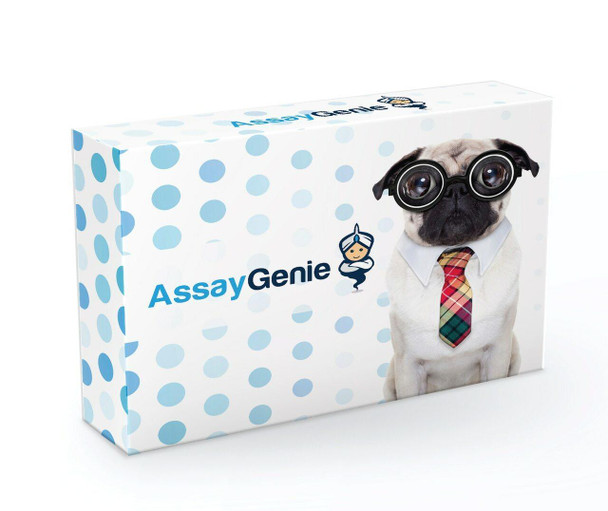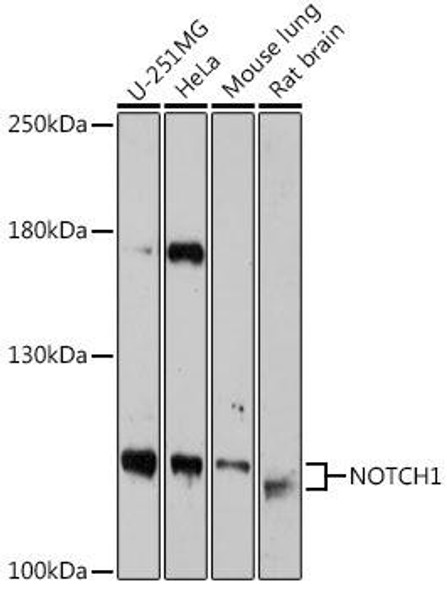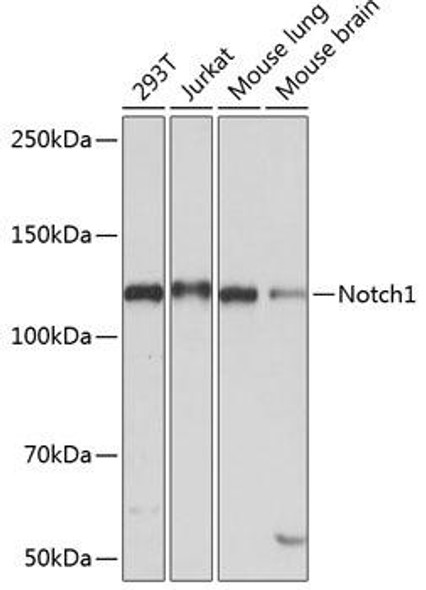Cardiovascular Antibodies
Anti-NOTCH1 Antibody (CAB16674)
- SKU:
- CAB16674
- Product Type:
- Antibody
- Reactivity:
- Human
- Reactivity:
- Mouse
- Reactivity:
- Rat
- Host Species:
- Rabbit
- Isotype:
- IgG
- Antibody Type:
- Polyclonal Antibody
- Research Area:
- Cardiovascular
Description
| Antibody Name: | Anti-NOTCH1 Antibody |
| Antibody SKU: | CAB16674 |
| Antibody Size: | 20µL, 50µL |
| Application: | IHC |
| Reactivity: | Human, Mouse, Rat |
| Host Species: | Rabbit |
| Immunogen: | A synthetic peptide of human NOTCH1 |
| Application: | IHC |
| Recommended Dilution: | IHC 1:50 - 1:200 |
| Reactivity: | Human, Mouse, Rat |
| Positive Samples: |
| Immunogen: | A synthetic peptide of human NOTCH1 |
| Purification Method: | Affinity purification |
| Storage Buffer: | Store at -20'C. Avoid freeze / thaw cycles. Buffer: PBS with 0.02% sodium azide, 50% glycerol, pH7.3. |
| Isotype: | IgG |
| Sequence: | Email for sequence |
| Gene ID: | 4851 |
| Uniprot: | P46531 |
| Cellular Location: | Cell membrane, Nucleus, Single-pass type I membrane protein |
| Calculated MW: | 272kDa |
| Observed MW: | Refer to figures |
| Synonyms: | AOS5, AOVD1, TAN1, hN1, NOTCH1, Activated NOTCH1, notch 1 |
| Background: | This gene encodes a member of the NOTCH family of proteins. Members of this Type I transmembrane protein family share structural characteristics including an extracellular domain consisting of multiple epidermal growth factor-like (EGF) repeats, and an intracellular domain consisting of multiple different domain types. Notch signaling is an evolutionarily conserved intercellular signaling pathway that regulates interactions between physically adjacent cells through binding of Notch family receptors to their cognate ligands. The encoded preproprotein is proteolytically processed in the trans-Golgi network to generate two polypeptide chains that heterodimerize to form the mature cell-surface receptor. This receptor plays a role in the development of numerous cell and tissue types. Mutations in this gene are associated with aortic valve disease, Adams-Oliver syndrome, T-cell acute lymphoblastic leukemia, chronic lymphocytic leukemia, and head and neck squamous cell carcinoma. |
| UniProt Protein Function: | Notch 1: Functions as a receptor for membrane-bound ligands Jagged1, Jagged2 and Delta1 to regulate cell-fate determination. Upon ligand activation through the released notch intracellular domain (NICD) it forms a transcriptional activator complex with RBPJ/RBPSUH and activates genes of the enhancer of split locus. Affects the implementation of differentiation, proliferation and apoptotic programs. May be important for normal lymphocyte function. In altered form, may contribute to transformation or progression in some T-cell neoplasms. Involved in the maturation of both CD4+ and CD8+ cells in the thymus. May be important for follicular differentiation and possibly cell fate selection within the follicle. During cerebellar development, may function as a receptor for neuronal DNER and may be involved in the differentiation of Bergmann glia. Represses neuronal and myogenic differentiation. May enhance HIF1A function by sequestering HIF1AN away from HIF1A. Heterodimer of a C-terminal fragment N(TM) and an N- terminal fragment N(EC) which are probably linked by disulfide bonds. Interacts with DNER, DTX1, DTX2 and RBPJ/RBPSUH. Also interacts with MAML1, MAML2 and MAML3 which act as transcriptional coactivators for NOTCH1. The activated membrane-bound form interacts with AAK1 which promotes NOTCH1 stabilization. Forms a trimeric complex with FBXW7 and SGK1. Interacts with HIF1AN. HIF1AN negatively regulates the function of notch intracellular domain (NICD), accelerating myogenic differentiation. In fetal tissues most abundant in spleen, brain stem and lung. Also present in most adult tissues where it is found mainly in lymphoid tissues. Belongs to the NOTCH family. |
| UniProt Protein Details: | Protein type:Motility/polarity/chemotaxis; Membrane protein, integral; Oncoprotein; Transcription factor; Receptor, misc. Chromosomal Location of Human Ortholog: 9q34.3 Cellular Component: nucleoplasm; Golgi membrane; endoplasmic reticulum membrane; cell surface; integral to membrane; acrosome; extracellular region; plasma membrane; cytosol; nucleus; receptor complex Molecular Function:enzyme inhibitor activity; protein binding; enzyme binding; chromatin DNA binding; sequence-specific DNA binding; receptor activity; calcium ion binding; transcription factor activity Biological Process: neural tube development; negative regulation of calcium ion-dependent exocytosis; positive regulation of apoptosis; heart development; positive regulation of transcription, DNA-dependent; positive regulation of JAK-STAT cascade; response to lipopolysaccharide; cell differentiation in spinal cord; negative regulation of BMP signaling pathway; response to corticosteroid stimulus; compartment specification; positive regulation of endothelial cell differentiation; negative regulation of ossification; oligodendrocyte differentiation; somatic stem cell division; negative regulation of osteoblast differentiation; positive regulation of astrocyte differentiation; positive regulation of cardiac muscle cell proliferation; positive regulation of keratinocyte differentiation; negative regulation of photoreceptor cell differentiation; positive regulation of neuroblast proliferation; organ regeneration; Notch receptor processing; keratinocyte differentiation; branching morphogenesis of a tube; response to muramyl dipeptide; positive regulation of transcription from RNA polymerase II promoter; negative regulation of transcription, DNA-dependent; determination of left/right symmetry; positive regulation of epithelial cell proliferation; foregut morphogenesis; endoderm development; cardiac muscle cell proliferation; cell fate specification; negative regulation of transcription from RNA polymerase II promoter; embryonic hindlimb morphogenesis; negative regulation of neurogenesis; negative regulation of cell proliferation; astrocyte differentiation; regulation of transcription, DNA-dependent; tissue regeneration; cardiac muscle morphogensis; positive regulation of cell proliferation; forebrain development; heart looping; regulation of somitogenesis; positive regulation of BMP signaling pathway; mesenchymal cell development; transcription initiation from RNA polymerase II promoter; Notch signaling pathway; hair follicle morphogenesis; in utero embryonic development; lumen formation; liver development; humoral immune response; activation of Notch receptor target transcription factor; negative regulation of oligodendrocyte differentiation; inflammatory response to antigenic stimulus; axonogenesis; negative regulation of catalytic activity; epithelial to mesenchymal transition; spermatogenesis; gene expression; immune response; sprouting angiogenesis; negative regulation of myoblast differentiation; auditory receptor cell fate commitment; positive regulation of cell migration; lung development Disease: Adams-oliver Syndrome 5; Aortic Valve Disease 1 |
| NCBI Summary: | This gene encodes a member of the Notch family. Members of this Type 1 transmembrane protein family share structural characteristics including an extracellular domain consisting of multiple epidermal growth factor-like (EGF) repeats, and an intracellular domain consisting of multiple, different domain types. Notch family members play a role in a variety of developmental processes by controlling cell fate decisions. The Notch signaling network is an evolutionarily conserved intercellular signaling pathway which regulates interactions between physically adjacent cells. In Drosophilia, notch interaction with its cell-bound ligands (delta, serrate) establishes an intercellular signaling pathway that plays a key role in development. Homologues of the notch-ligands have also been identified in human, but precise interactions between these ligands and the human notch homologues remain to be determined. This protein is cleaved in the trans-Golgi network, and presented on the cell surface as a heterodimer. This protein functions as a receptor for membrane bound ligands, and may play multiple roles during development. [provided by RefSeq] |
| UniProt Code: | P46531 |
| NCBI GenInfo Identifier: | 11275980 |
| NCBI Gene ID: | 4851 |
| NCBI Accession: | |
| UniProt Secondary Accession: | P46531,Q59ED8, Q5SXM3, |
| UniProt Related Accession: | P46531,Q6IAD4,Q9NXX4 |
| Molecular Weight: | 272,505 Da |
| NCBI Full Name: | NOTCH 1 |
| NCBI Synonym Full Names: | notch 1 |
| NCBI Official Symbol: | NOTCH1 |
| NCBI Official Synonym Symbols: | hN1; TAN1 |
| NCBI Protein Information: | neurogenic locus notch homolog protein 1; OTTHUMP00000022594; Notch homolog 1, translocation-associated; translocation-associated notch protein TAN-1 |
| UniProt Protein Name: | Neurogenic locus notch homolog protein 1 |
| UniProt Synonym Protein Names: | Translocation-associated notch protein TAN-1 |
| Protein Family: | Neurogenic locus notch homolog protein |
| UniProt Gene Name: | NOTCH1 |
| UniProt Entry Name: | NOTC1_HUMAN |





![Anti-NOTCH1 Antibody (CAB7636)[KO Validated] Anti-NOTCH1 Antibody (CAB7636)[KO Validated]](https://cdn11.bigcommerce.com/s-rd6ounxcu2/images/stencil/590x590/products/47789/52533/anti-notch1-antibody-cab7636ko-validated__14438__28389.1706525551.jpg?c=1)
